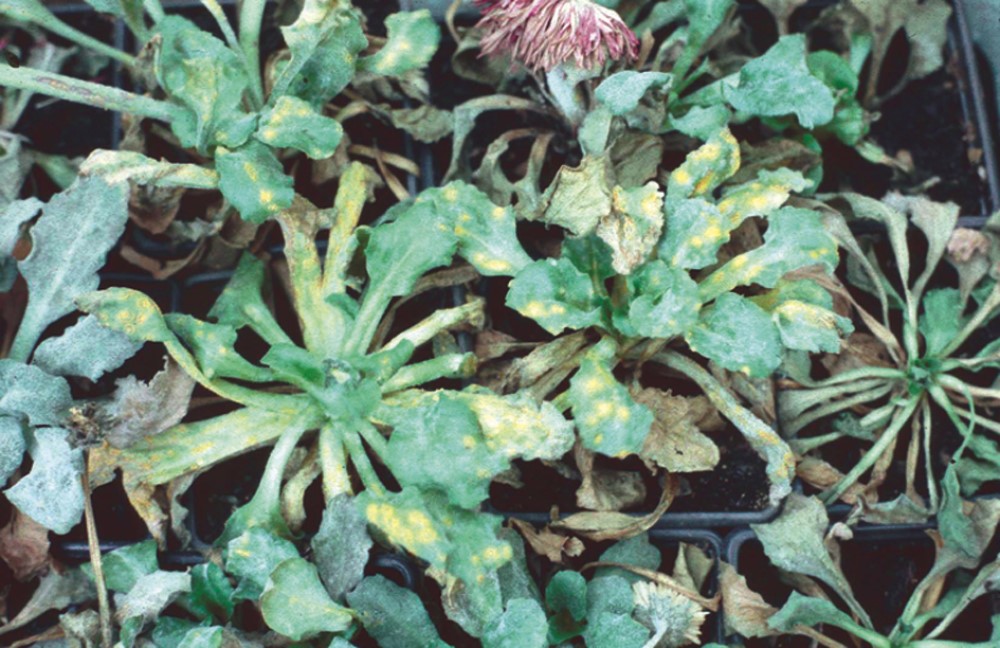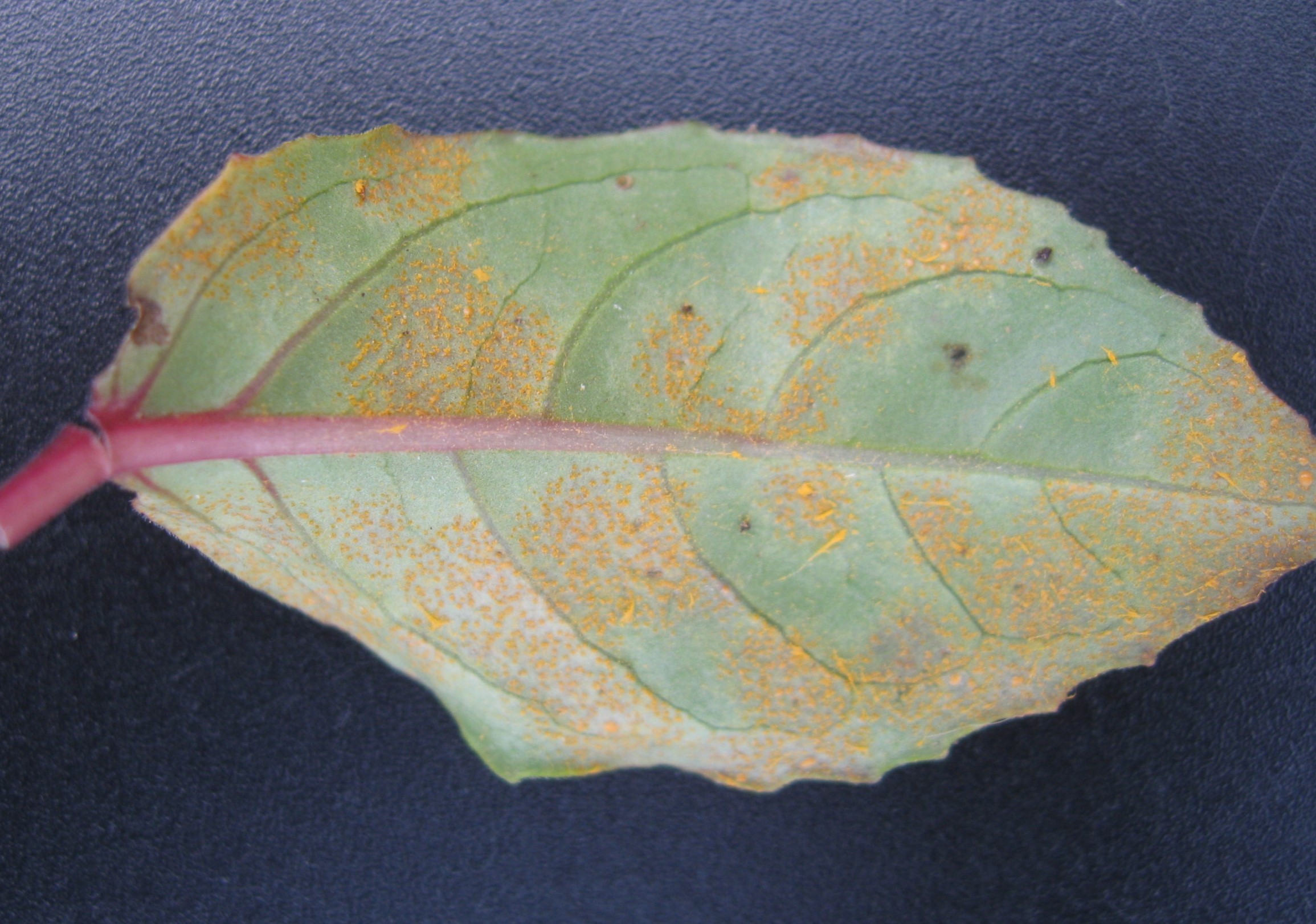Please click here to access the main AHDB website and other sectors.
- Home
- Knowledge library
- Symptoms and mechanisms of spread and the life cycle of rust pathogens
Symptoms and mechanisms of spread and the life cycle of rust pathogens
Find out how to identify rust symptoms on infected bedding and pot plants and prevent the introduction and spread of rust diseases.
Back to: Control of rust diseases on protected ornamentals
How to identify rust symptoms
Awareness of rust symptoms is key to early detection and effective disease management. Most susceptible bedding and pot plant species are affected by only one species of rust, usually specific to that crop. However, chrysanthemums are susceptible to two (white and brown rust), while bellis is susceptible to three different species, all producing orange or brown coloured spores.
Disease symptoms can look different depending on the host plant and fungal species, but a common feature of rust diseases is the production of large numbers of dusty spores.
Early rust symptoms typically appear on leaf undersides as small blisters, often with localised plant tissue yellowing on the upper leaf surface. Spore pustules eventually break through the lower leaf surface. Pustules may also be produced on the upper leaf surface, stems and flower parts (not usually on petals) depending on the rust species and the severity of infection.
Spore colour varies between, and even sometimes within, the different rust species and can be white, yellow, orange, brown (rust coloured) or black. Spore colouration and other characteristic symptoms of different rusts are summarised in the table below.
Rust species affecting bedding and pot plants, with rust spore colouration and other characteristic symptoms
|
Plant host |
Rust species |
Spore colour |
Other symptoms |
|
Antirrhinum |
Puccinia antirrhini |
Chocolate-brown |
Leaf distortion, yellowing of upper leaf surface. Pustules often form in rings |
|
Bellis |
Puccinia distincta |
Orange or occasionally brown |
Upright leaves, wilting of severely affected plants. Flower stalks affected |
|
Puccinia obscura |
Orange |
Leaf purpling |
|
|
Puccinia lagenophorae |
Orange or occasionally brown |
|
|
|
Carnation/pinks |
Uromyces dianthi |
Dark brown |
Pustules often form in rings on upper and lower leaf surfaces |
|
Chrysanthemum |
Puccinia chrysanthemi (Brown rust) |
Red-brown |
Pustules often form in rings. Yellow spots on upper leaf surface |
|
Puccinia horiana (White rust) |
Pink/buff. White at high humidity |
Yellow spots on upper leaf surface, becoming sunken and brown |
|
|
Cineraria |
Coleosporium tussilaginis |
Orange |
|
|
Puccinia leganophorae |
Orange |
|
|
|
Fuchsia |
Pucciniastrum epilobii |
Yellow to bright orange |
Yellow, purple or red/brown discolouration of upper leaf surface on some varieties. Underside may be completely covered by pustules |
|
Pelargonium |
Puccinia pelargonii-zonalis |
Cinnamon-brown |
Pustules often form in rings. Yellow spots on upper leaf surface |
|
Sweet william |
Puccinia arenariae |
Dark brown. Greyish at high humidity |
Sunken, yellow spots on upper leaf surface |
Note. White blister on cineraria (caused by Albugo tragopogonis), is sometimes known as white rust as its pustules resemble those of rusts. However, this pathogen is related to downy mildews not rusts.
Bellis rust – severe rust infection leading to unmarketable plants

Image © ADAS Horticulture
Antirrhinum rust – extremely severe rust infection affecting leaves, leaf petioles and even stems

Image © John Scrace.
Fuchsia rust – bright orange pustules on the lower leaf surface, often with red or purple spotting on the upper leaf surface

Image © John Scrace
Even low levels of rust symptoms on bedding plants will render them unmarketable. In addition, infected plants will suffer from leaf loss and reduced vigour. Although rusts may occasionally kill young plants, mature plants rarely succumb. Antirrhinum is an exception, and infection is often so severe that plant death results.
Sources and spread of rust diseases
- Rust spores are spread locally via air currents and water splash and can be wind-blown over longer distances
- The disease can be introduced to the nursery on infected plants and cuttings
- Rust infections can remain latent from seven days to several weeks before symptoms develop, and so infected plant material can be unknowingly brought onto nurseries
- Spores of most bedding and pot plant rusts can survive for weeks or even months on plant debris, such as detached leaves, allowing them to survive during a break between host crops
- Although optimal environmental conditions for disease development vary between rust species, leaf wetness is a key factor. Prolonged periods of leaf wetness and suitable temperatures (16 to 24°C for most rust species) enable spores to germinate and infect plants through stomata within a few hours. Spore germination will be inhibited at high temperatures (~27°C+). Therefore, most rusts are more common in the autumn, winter and spring, when controlling humidity and leaf wetness is more difficult
Rust life cycles
The life cycle of rusts can be complex, in some cases involving up to five different spore types. The production of different spore types results in pustule colours differing under certain conditions or at different times of the year. For example, chrysanthemum white rust pustules change from buff to white when the humidity is high.
Many rust species need to infect a second plant species to complete their life cycle. Fuchsia rust (Pucciniastrum epilobii) spends part of its life cycle on fir trees (Abies species). However, there is no proven risk to fuchsia from fir trees in the proximity of nurseries.
The life cycle of rusts on most bedding and pot plants, including antirrhinum, chrysanthemum, dianthus and pelargonium is fairly simple, producing just one or two spore types on the host plant.
Useful links
Crop Walkers' Guide: Bedding & Pot Plants
Webpage content correct as of March 2021
Author(s) – Dave Kaye and Erika Wedgwood, ADAS Horticulture.
Original author(s) – Tim O’Neill and John Scrace, ADAS Horticulture.
Topics:
Sectors:
Tags:

